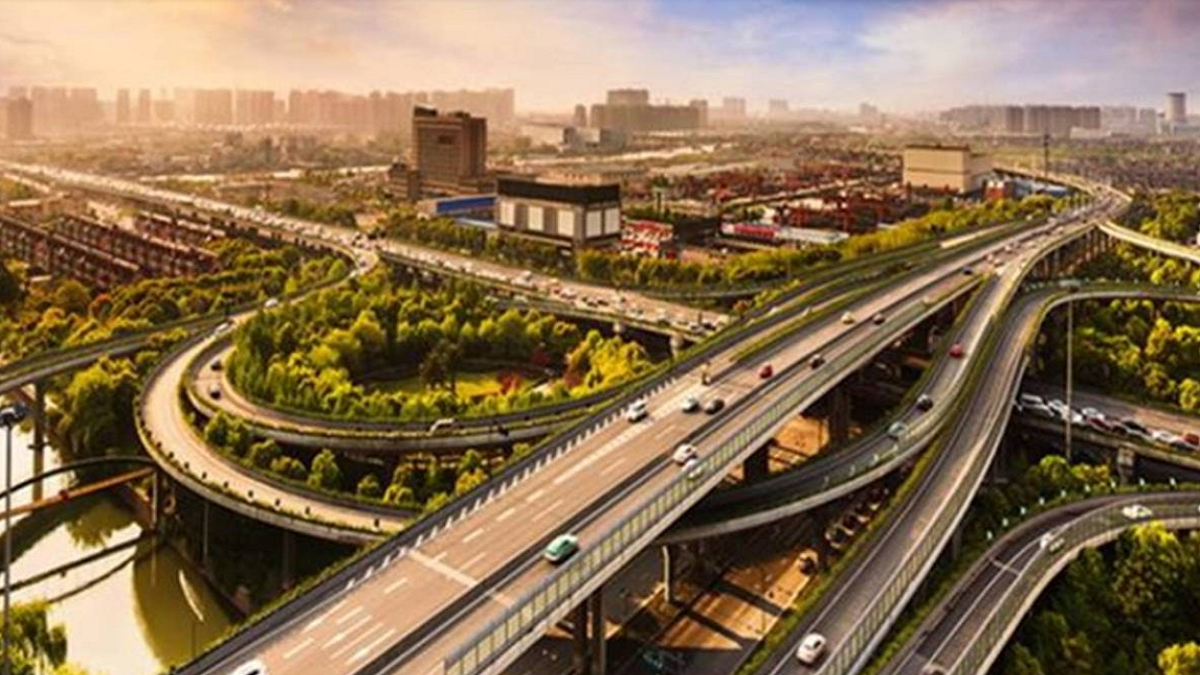
The Delhi-Mumbai Industrial Corridor Project (DMIC) is an ongoing industrial development project between Delhi and Mumbai. This project was conceived initially from a thought from the Japanese Ambassador to India about having smart and faster transport of iron ores to India’s ports from its landlocked states. Later it was converted to a well-thought and planned industrial corridor in the western part of India which has better access and a good number of ports.
Launched in pursuance of an agreement between India and Japan in December 2006, the world’s largest infrastructure project, with an estimated investment of $90 billion, is planned as a high-tech industrial zone spread across six states. The investments will be spread across the 1,500-km-long rail transportation project, namely the Western Dedicated Freight Corridor (WDFC), which will serve as the industrial corridor’s transportation backbone.
DMIC includes 24 industrial regions, eight smart cities, two international airports, five power projects, two mass rapid transit systems and two logistical hubs. The eight investment regions proposed to be developed in Phase I of DMIC are DadriNoida-Ghaziabad (in Uttar Pradesh), Manesar-Bawal (in Haryana), KushkhedaBhiwadi-Neemrana and Jodhpur-Pali-Marwar (in Rajasthan PithampurDhar- Mau (in Madhya Pradesh), Dholera Special Investment Region (in Gujarat), and Aurangabad Industrial City (AURIC) and Dighi Port Industrial Area in Maharashtra.
The spread of DMIC is as follows:
Conceived as a global manufacturing and trading hub, the project is expected to double employment potential, triple industrial output and quadruple exports from the region. The project is expected to generate 3 million jobs, largely in manufacturing, as per the DMIC website. The labour availability is approximately 50 million in the immediate influence zone and over 250 million across the states where the project will pass through.
In the post-Covid world, the bigger concern of migration from rural to urban areas can be addressed here with the basic concept of DMIC’s command area or impact area. The whole region of DMIC can retain the rural population in its vicinity. People can come, work and get back to their villages by the evening. 24 industrial regions across the 1500 KM of stretch mean one industrial region for every 62.5 KM. From the centre of each node, the nearest industrial region would be connected at a distance of 32 km. This project can set the roadmap to several such projects in the country and address the challenge of congestion and quality of life in the cities.
Dholera SIR in Gujarat and AURIC city in Aurangabad, Maharashtra are the two projects which are already running as per its planned schedule and are ready to host industries from around the world with its world-class infrastructure. Dholera SIR is a huge project, spread over 920 sq km, at a distance of 70 km from Ahmedabad, making it very strategically located. It has its own proposed seaport and international cargo airport. Already, 72 sq km of area in the first phase is ready to welcome industries with plug & play facilities. With all the basic infrastructural facilities like ETP, WTP, STP, electricity, drainage and stormwater clearances already in place, the industries can move in at any point in time. India can offer outbound industries from China, post the CCovid-19 spread, to Dholera SIR. They will be able to start production within six months’ time.
AURIC is located 15 km from Aurangabad and 8 km east of the Aurangabad Airport. It is planned as a new industrial corridor, with the total area of AURIC measuring 84.17 sq km divided into two parts. Part-I consists of 41.42 sq km, which is further divided into two phases. Phase-I covers 8.39 sq km, located north of Jalna Road and adjoining the existing MIDC Shendra Industrial Park. Phase-II includes the remaining area of 32.03 sq km, located near Bidkin.
The 1700 km length of the DMIC has a command area of 5,30,318 sq km and its impact will be upon seven thickly populated states. If the project of the express roads and the industrial cluster is taken up as a priority, we can convert the opportunity to retain the rural population by employing them locally. This will also create a big opportunity for new entrepreneurs from rural areas. Farmers will have better reach to transport their produce to ports, mandis or customers, which will eventually make them richer. The western corridor also has better access to some of the biggest ports in the country like Mundra, Kandla, Hazira, JNPT and Pipavav. The corridor can be a key driver in the emerging export demand for Indian agri-produce which are considered immunity boosters.
The government at the helm is well aware of the fact of the matter and is progressing in new directions to cope with the situation which has emerged from the coronavirus pandemic and its mitigation. The government must work upon this project closely to drive it ahead from its present state as it will boost growth by investing in infrastructure projects which will lead eventually to a better rural-urban model of the economy. This project has the potential to become an expressway for exports for the entire north and central Indian areas if implemented as planned. The lead of this project must be given to a person like E. Sridharan, the “Metro Man”, who can take this project as a challenge to be completed within the next two years. Remember, the next two years will be a deciding factor for India — whether it wishes to become an alternative to China or surrender to it!
The writer is Research Scholar, Sardar Vallabhbhai National Institute of Technology, Surat.